
The meat ant, also known as the gravel ant or southern meat ant, is a species of ant endemic to Australia. A member of the genus Iridomyrmex in the subfamily Dolichoderinae, it was described by British entomologist Frederick Smith in 1858. The meat ant is associated with many common names due to its appearance, nest-building behaviour and abundance, of which its specific name, purpureus, refers to its coloured appearance. It is among the best-known species of ant found throughout Australia; it occurs in almost all states and territories except for Tasmania. Its enormous distribution, aggression and ecological importance have made this ant a dominant species.
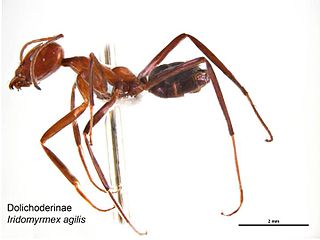
Iridomyrmex agilis is an ant of the genus Iridomyrmex. They are distributed throughout most of Australia. They are usually found in the drier regions of Australia. The species was described by Forel in 1907.

Iridomyrmex anceps is an ant species of the genus Iridomyrmex. It has a very large distribution in multiple continents, but it is mainly distributed in northern Australia. Some specimens were found in multiple islands, and some were even found and collected in the United Arab Emirates.
Iridomyrmex bicknelli is a species of ant belonging to the genus Iridomyrmex. The species is distributed in every single state and territory in Australia. Iridomyrmex bicknelli was described by Emery in 1898.

Iridomyrmex chasei is an ant belonging to the genus Iridomyrmex. The species was described by Forel in 1902, the species is mainly abundant nationwide in Australia, with an exception of its presence in Tasmania. This species is widely known for its large and highly populated nests.
Eldermyrmex is an extinct genus of ant in the Formicidae subfamily Dolichoderinae. The genus contains a single described species Eldermyrmex oblongiceps. Eldermyrmex is known to be from the Baltic Amber.
Iridomyrmex brennani is a species of ant in the genus Iridomyrmex. Described recently in 2011, specimens were collected from Victoria, South Australia and Western Australia in the Kambalda district.
Iridomyrmex cupreus is a species of ant in the genus Iridomyrmex. Described in 2011, specimens have only been collected in Lake Eyre in South Australia.

Iridomyrmex exsanguis is a species of ant in the genus Iridomyrmex. Described by Forel in 1907, the species is distributed nationwide in Australia.
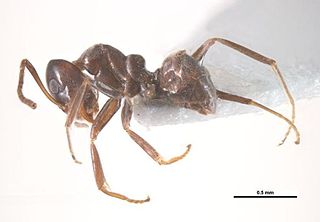
Iridomyrmex gibbus is a species of ant in the genus Iridomyrmex. Described by Heterick and Shattuck in 2011, the biology of the ant is not exactly known, although it is known that the ant is distributed in several states and in Barrow Island in Australia.

Iridomyrmex lividus is a species of ant in the genus Iridomyrmex. Described by Shattuck in 1993, the ant is endemic to Australia and resembles a similar appearance to the Meat ant.
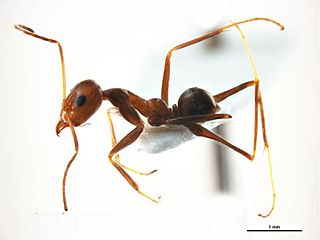
Iridomyrmex minor is a species of ant in the genus Iridomyrmex. Described by Forel in 1915, the ant is common in Western Australia, South Australia, Northern Territory and Queensland, and it is unlikely there are existing colonies in more southern Australian states. Nests have been found under bark, and is among the most likely ant to be encountered by the general public.
Iridomyrmex niger is a species of ant in the genus Iridomyrmex. Described by Heterick and Shattuck in 2011, the species is endemic to multiple states in Australia.
Iridomyrmex omalonotus is a species of ant in the genus Iridomyrmex. Described by Heterick and Shattuck in 2011, the ant is endemic to Australia, and the ants are known for its attraction to honey, and attends to lycaenid caterpillars and other Hemiptera that produces honey.

Iridomyrmex rufoniger is a species of ant in the genus Iridomyrmex. It was described by Lowne in 1865. The species is endemic to Australia and introduced to several other countries.
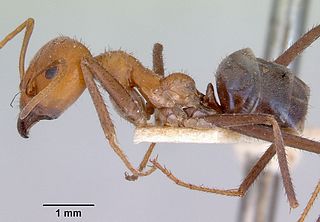
Iridomyrmex sanguineus is a species of ant in the genus Iridomyrmex. The ant is endemic to Australia and was described by Forel in 1910.

Iridomyrmex spadius is a species of ant in the genus Iridomyrmex. Described by Shattuck in 1993, localised populations of the species can be found in Queensland, Australia.
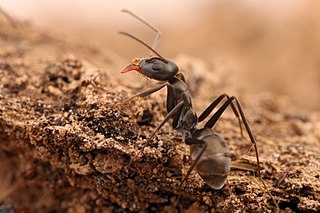
Iridomyrmex splendens is a species of ant in the genus Iridomyrmex. Described by Forel in 1907, the ant is mainly distributed in the southern regions of Australia, commonly found in dry sclerophyll woodland, and nests are found under logs.
Gracilidris humiloides is an extinct species of ant in the genus Gracilidris. It was discovered in the Dominican amber, only known from a single specimen, described by Wilson in 1985.













